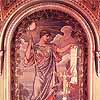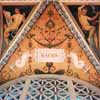
TABLE
OF CONTENTS - Introduction - A
Brief History of the Library of Congress
The Thomas Jefferson Building - The
John Adams Building - The James Madison Memorial
Building
Author's Note and Acknowledgements - Further
Reading - Concordance of Images
A BRIEF HISTORY OF THE LIBRARY OF CONGRESS
The oldest cultural institution in the nation's capital, the Library of Congress occupies a unique place in American civilization. Established as a legislative library in 1800, it grew into a national institution in the nineteenth century, a product of American cultural nationalism. Since World War II, it has become an international resource of unparalleled dimension and the world's largest library. In its three massive structures on Capitol Hill, the Thomas Jefferson, John Adams, and James Madison Memorial Buildings, the Library of Congress brings together the concerns of government, learning, and librarianship--an uncommon combination, but one that has greatly benefited American scholarship and culture.
 Minerva,
by Elihu Vedder, a marble mosaic on the landing of the stairs
leading to the Visitors' Gallery above the Main Reading Room. Minerva
is depicted as a guardian of civilization and promoter of the arts
and sciences.
Minerva,
by Elihu Vedder, a marble mosaic on the landing of the stairs
leading to the Visitors' Gallery above the Main Reading Room. Minerva
is depicted as a guardian of civilization and promoter of the arts
and sciences.
The history of the Library of Congress is the story of the accumulation of diverse functions and collections. As a repository of information and knowledge, its collections in all formats now contain more than 103 million items--books (about 20 million), films, maps, photographs, music, manuscripts, and graphics--from all over the world. The scope of these collections is universal; materials have been acquired in more than four hundred and fifty languages. The Library is open to everyone over high school age, and more than two million tourists visit it annually.
The Library of Congress has been shaped primarily by the philosophy and ideas of its principal founder, Thomas Jefferson, who believed that a democratic legislature needed information and ideas in all subjects to do its work. It was established by Congress on April 24, 1800, with an appropriation of five thousand dollars, as the government prepared to move from Philadelphia to the new capital city of Washington. From the beginning, however, the institution was more than a legislative library, for an 1802 law made the appointment of the Librarian of Congress a presidential responsibility. It also permitted the president and vice president to borrow books, a privilege that eventually was extended to the judiciary, officials of government agencies, and, under certain conditions, members of the public. Originally located in the Capitol Building, the Library moved to its own building in 1897. At the same time, Congress gave the Librarian of Congress sole responsibility for making the Library's rules and regulations and invested in the Senate the authority to approve a president's nomination of a Librarian of Congress.
Thomas Jefferson took a keen and continuing interest in the Library. In 1814, when the British invaded Washington, they destroyed the Capitol, including the Library of Congress. By then retired to Monticello, Jefferson offered to sell his personal library of more than six thousand volumes to Congress. The purchase was approved in 1815, doubling the size of the Library. It also expanded the scope of the collections. Anticipating the argument that his collection might be too wide-ranging and comprehensive for use by a legislative body, Jefferson argued that there was "no subject to which a member of Congress may not have occasion to refer." The Jeffersonian concept of universality is the philosophy and rationale behind the comprehensive collecting policies of today's Library.
The individual responsible for transforming the Library of Congress into an institution of national significance was Ainsworth Rand Spofford, Librarian of Congress from 1864 to 1897. Spofford applied Jefferson's philosophy on a grand scale. He linked the Library's legislative and national functions, building a comprehensive collection for both the legislature and the nation. In obtaining greatly increased support from Congress, Spofford employed a combination of logic, flattery, and nationalistic rhetoric. In 1867 his acquisitions made the Library of Congress the largest library in the United States. Spofford's other major achievements were the centralization in 1870 of all U.S. copyright activities at the Library--which ensured the continuing growth of the collections by stipulating that two copies of every book, pamphlet, map, print, and piece of music registered for copyright be deposited in the Library--and construction of a separate building, a twenty-six year struggle not completed until 1897.
Spofford's concept of the Library of Congress as both legislative library for the American Congress and national library for the American people has been wholeheartedly accepted by his successors. Herbert Putnam, Librarian of Congress from 1899 to 1939, extended this philosophy still further. To Putnam, a national library was more than a comprehensive collection housed in Washington. It was "a collection universal in scope which has a duty to the country as a whole." He defined that duty as service to scholarship, both directly and through other libraries.
 Francis
Bacon is one of the great authors whose name appears in the vaulted
cove of the ceiling of the Great Hall in the Jefferson Building.
The date "1896" and the name of the painter, Frederic C. Martin,
can be seen in the upper left corner.
Francis
Bacon is one of the great authors whose name appears in the vaulted
cove of the ceiling of the Great Hall in the Jefferson Building.
The date "1896" and the name of the painter, Frederic C. Martin,
can be seen in the upper left corner.
The first experienced librarian to fill the position, Putnam felt that a national library should actively serve other libraries, and he immediately began such a service. Through the sale and distribution of printed catalog cards, union catalogs, interlibrary loan, and other innovations, he "nationalized" the Library's collections and established the patterns of service that exist today. During his tenure, the Library helped systemize American scholarship and librarianship through the widespread sharing of its bibliographic apparatus, thus encouraging a national view of scholarship and research collections and establishing pioneering partnerships between the federal government and the private sector.
Balancing its legislative, national, and, after World War II, international roles, the Library of Congress has grown steadily. Historically, its major problem has been lack of space, not lack of support. Librarian of Congress Archibald MacLeish (1939-1944) stressed the Library's roles as a symbol of democracy and a cultural institution. Luther H. Evans (1945-1953) pushed forward the Library's bibliographic and international activities. L. Quincy Mumford (1954-1974) greatly expanded all the Library's roles, but particularly its bibliographic activities and foreign acquisitions.
A new public role for the Library began to emerge under the leadership of historian Daniel J. Boorstin, Librarian of Congress, 1975-1987. Emphasizing the Library's role as a national cultural resource, he greatly increased the institution's visibility. Boorstin's successor, historian James H. Billington (1987-), has vigorously pursued a similar course. He also has established private sector support groups and an educational role for the Library, using new technologies to share the Library's collections with the nation. As it approaches its bicentennial in the year 2000, the Library of Congress is still guided by Thomas Jefferson's belief that information and knowledge about all subjects are essential in a democracy--for legislators and citizens alike.
TABLE
OF CONTENTS - Introduction - A
Brief History of the Library of Congress
The Thomas Jefferson Building - The
John Adams Building - The James Madison Memorial
Building
Author's Note and Acknowledgements - Further
Reading - Concordance of Images
Contact Us ( January 11, 2006 )